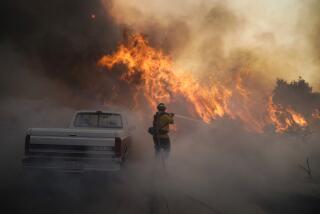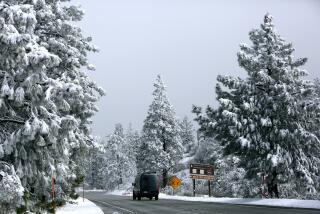California’s wildfires are deterring tourists and hitting taxpayers hard, officials say

This summer’s relentless California wildfires have claimed at least a dozen lives and destroyed more than 1,200 homes. But along with the loss of life and property, the blazes have also taken a tremendous toll on taxpayers and the state’s huge tourism industry.
In less than two months, California has nearly wiped out the emergency wildfire funds set aside for the entire fiscal year, spending about $405 million out of the nearly $443 million allocated.
Tourism officials, meanwhile, have complained that televised images of the wildfires are deterring visitors, especially international travelers.
“We haven’t had a break,” said Scott McLean, a spokesman for the California Department of Forestry and Fire Protection. “One fire is coming close to the end and another one starts right up. It’s been a revolving door for our firefighters … and it’s definitely going to get into the funds.”
The financial hit comes well before what’s supposed to be peak fire season, which means California will probably need to once again dip into its overall budget reserve, which is about $2 billion. The state has done so for seven of the last 10 years, said H.D. Palmer of the Department of Finance.
The deadly Carr fire — which ripped through almost 230,000 acres and destroyed more than 1,000 homes — cost a total of $152 million alone in firefighting costs, McLean said. He did not yet have totals for the Mendocino Complex, which consists of two blazes whose combined acreage make up the largest fire in California history.
Additional costs include fire prevention programs, damages and personal losses, many of which are handled by private insurance companies. The state’s Office of Emergency Services will sometimes allocate funds for relief and recovery of business and homeowners that suffer from large fires, Palmer said.
The finances highlight “the effect climate change has had on California and the trouble of these catastrophic fires,” Palmer said. “On a budget basis it underscores the importance of maintaining an adequate budget reserve to cover the additional cost that occurs when you have fires of this scope and severity.”
The annual emergency fund budget is calculated based on what was actually spent in the previous five years, but “sometimes Mother Nature is going to ignore that trend,” Palmer said.
Last year, California set aside nearly $427 million for wildfires, but the total cost to the state ended up being about $774 million, McLean said. With federal and local expenses, the total cost was about $896 million, according to the Department of Finance.
It’s a dramatic increase from the 2007-08 fiscal year, when the wildfire emergency fund appropriation was about $82 million and the state’s total cost was $372 million. The emergency fund is separate from Cal Fire’s general fund, which covers expenses for daily operations and routine fires.
In large fires such as the Mendocino Complex, the federal government will typically cover about 70% of the cost, but that varies year to year.
“We will never have a situation where you haggle over splitting the check when the restaurant is on fire,” Palmer said.
Despite the growing cost of fighting fires, Palmer said dipping into the reserves is a standard practice. “There will always be available cash on hand to make sure crews are deployed and tankers will fly,” he said.
On the tourism front, a recent study found that 11% of would-be travelers to California said the fires have prompted them to cancel their trips, costing the industry as much as $20 million last month, said Caroline Beteta, head of Visit California, the nonprofit marketing agency for the state.
But Beteta, along with tourism officials in Oregon and Washington, said wildfires burning in the three states are primarily in rural regions, not most tourist destinations. “Our visitor experience remains unaffected by the fires,” she said. “We want to welcome people back as soon as possible.”
A notable exception was Yosemite Valley, which was closed for nearly three weeks as the Ferguson fire raged nearby during what is typically the busiest camping season of the year.
Sydney Zaph and her family traveled to California from South Dakota, but decided to cut Yosemite National Park from their list of road trip destinations because of the blaze.
Instead, they camped at O’Neill Regional Park in Orange County. During their trip, though, the Holy fire erupted just a few miles away, charring more than 22,000 acres and destroying at least 18 homes. Authorities have said the fire was an act of arson and arrested someone accused of setting the blaze.
“We just need to be aware of what’s happening,” said Zaph’s sister, Robin Mischke, from a folding chair at the campsite.
More to Read
Start your day right
Sign up for Essential California for news, features and recommendations from the L.A. Times and beyond in your inbox six days a week.
You may occasionally receive promotional content from the Los Angeles Times.









